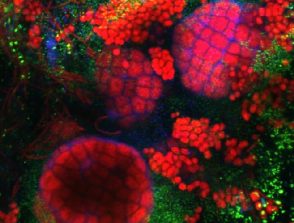The fate of crustal carbonaceous matter in subduction zones and its implications for diamond formation
Start: 04 October 2021
Supervisors :
Baptiste Debret, Bénédicte Menez, Julien Siebert
Related teams :
Lithosphere Organosphere Microbiosphere (LOMs)
Status: In progress
Recent thermodynamic and experimental studies have suggested that organic compounds can be stable in subduction zones up to high pressures and temperatures. Beyond these theoretical studies, condensed organic carbon phases were now found to be widespread in the subducting plate, being either formed by carbonates destabilization during subduction or inherited from hydrothermal circulation at oceanic ridges and rock-hosted biologically activity. Those can therefore constitute a relevant starting material at the origin of diamond nucleation and formation at high pressure in subduction zones and hence play a fundamental role in the deep organic carbon cycle contributing to geochemical heterogeneities encountered in the deep mantle. To assess the origin of the condensed organic phases, their fate during subduction and their potential link with diamond formation, we run high pressure and high temperature experiments. Those will involve natural serpentinites associated with synthetic carbonaceous matter or carbonates and will assess their fate during serpentinite devolatilization over a large range of pressure (3-10 GPa) and temperature (500-1500°C) at various redox buffer conditions. These experiments investigate the interplay between Fe-bearing phases (which have a strong reducing power in those environments), carbonates and organic carbon during three key dehydration reactions in subduction zones: brucite breakdown, antigorite breakdown and chlorite breakdown. We characterize at the microscale the nature and structure of the organic content in the experimental products by using a suite of high resolution spectroscopic and imaging techniques (SEM-EDS; SEM-FIB; FTIR; SNOM; TEM; HR-TEM; EELS; Raman, nanoSIMS) and propose a model of formation based on mineralogical and petrological constrains. These observations will be combined with thermodynamic modelling of carbon speciation along a P-T path of subduction using the Deep Earth Water model in order to constrain the speciation of redox sensitive elements in metamorphic rocks and fluids during subduction.




